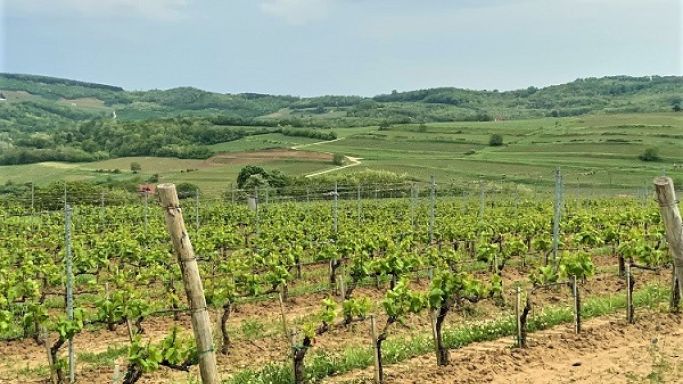Finding the old soul of Hungary in a modern, new-generation Kadarka.
From 2,760 Hungarian forints, €10.50, £10.95, $20.99
With twinkling eyes, rosy smiling cheeks and a snowy white beard that could have him in Lapland surrounded by elves, Zoltán Heimann throws his hands up and rolls his eyes, ‘I’m serious! Who the heck wants to get a Cabernet from Hungary in London?!’
He has a point, and in turn, I’m about to try to persuade you likewise.
We’re in Szekszárd in southern Hungary, and this is red-wine country. It’s pouring with rain and purple-finger cold and as I am being assured that it is usually warm and very, very sunny, I hunker further down into my jacket.
Better known for its Bikavér blends (not as well known to us as the Egri Bikavér found further north in Eger) and red wines made from international varieties such as Merlot, Cabernet Franc and Cabernet Sauvignon, Szekszárd traditionally makes big, fiery, velvety wines. Kadarka and Kékfrankos were the traditional red varieties of the region, much celebrated in the 18th and 19th centuries, but war, poverty and communism had taken their toll, and varieties that were easier to grow and higher-yielding filled the vineyard areas.
Kadarka – light coloured, fussy to grow, thin-skinned, susceptible to botrytis – was the everyday drinking wine, its vines covering two-thirds of the Hungarian vineyard area until phylloxera hit. Industrialisation under the communist regime reduced it to 380 ha (940 acres) from 60,000 ha (148,265 acres). It sunk into obscurity, ignored by everyone but the most stoic traditionalists, and was mostly blended away or made into rosé for spritzer.
There is, however, a revival going on. Armed with international experience, modern education and more economic freedom than their parents had, the generation starting to take the reins in Hungarian wineries is in an unprecedented position to create fine wine that oenophiles will take seriously. They’re also rekindling an interest in native varieties.

Zoli Heimann, the eldest son of Zoltán (pictured above between his father on the left and medical doctor brother on the right), is one such young man. He spent six years studying viticulture and oenology at Geisenheim, Montpellier, Bordeaux and Udine. He’s now home, taking over more and more of the vineyard and cellar work from his parents, and in the process is part of the generation fashioning the new, finer face of Szekszárd.
He’s fluent in English (the whole family is), greeting us with laughter when he arrived a little late, saying, ‘I went to put a fancier pullover on…’ But despite the jokes, family banter and humour evident in the artwork on their amphorae (each painted by a different local artist, as shown below), this family take wine very seriously, Kadarka in particular.

Concerned by how small the clonal pool had become since the 1950s, availability reduced to only the high-yielding, rot-resistent clones, Zoltán Snr began a huge clonal research programme into the variety 25 years ago, working with the Pécs University Research Institute to collect a database of every old vineyard they could find, particularly those over 80 years old, grafting them in nurseries and studying the results. They’ve chosen seven of the clones to plant in their own vineyards.

Zoli is convinced that the variety has huge potential as a fine varietal wine and has started stripping out use of new oak, using amphorae, and is fermenting with indigenous yeast parcel by parcel, focusing on the single-vineyard bottlings with varietal characteristics amplified by terroir and unobscured by heavy-handed winemaking.
Their single-vineyard Kadarkas are stunning, but for an introduction to the variety, you couldn’t do better than their entry-level Kadarka. At just £11 from The Wine Society and 12.5% alcohol, it’s kind to the wallet and kind to the body (Tasting through all the wines I realise that Zoli has that special gift for coaxing depth and beauty out of fruit at very low alcohols.) It has such a freshness and gentle, spiced cherry sweetness that it’s also kind to the soul.
After spontaneous fermentation in stainless steel it spent five months in big wooden casks (10 hl/265 gallons and 50 hl/1,320 gallons). Residual sugar is less than 1 g/l, total acidity is 4.7 g/l and production is 17,560 bottles. 2017 was a very ripe year, so they picked early to keep the freshness.
Although comparisons are indeed odious, the wine has a Pinot-like clarity with gentle yet firm tannins, like a child’s hand pressed against yours. Cherry menthol and a bit of fennel spice, strawberries and the sharper note of Victoria plum. Appetising, zesty wine with fine acidity, and for summer could easily be lightly chilled. VGV indeed!
In the UK, you can snap it up from The Wine Society for £10.95 or from Novel Wines in Somerset for £16.99. It’s available in Hungary, in Germany from €10.50 and in The Netherlands from €12.50. In Pennsylvania the Liquor Control Board sells it for $20.99 and in California, Blue Danube Wine sells it for $21.95. You can also get older vintages in Poland and elsewhere in the US, although this entry-level Kadarka is not made to age so I wouldn’t put myself out to buy anything older than the 2016.
Look out for any of the Heimann wines – they’re excellent across the board. Without doubt, it’s a name to watch in the years to come.


